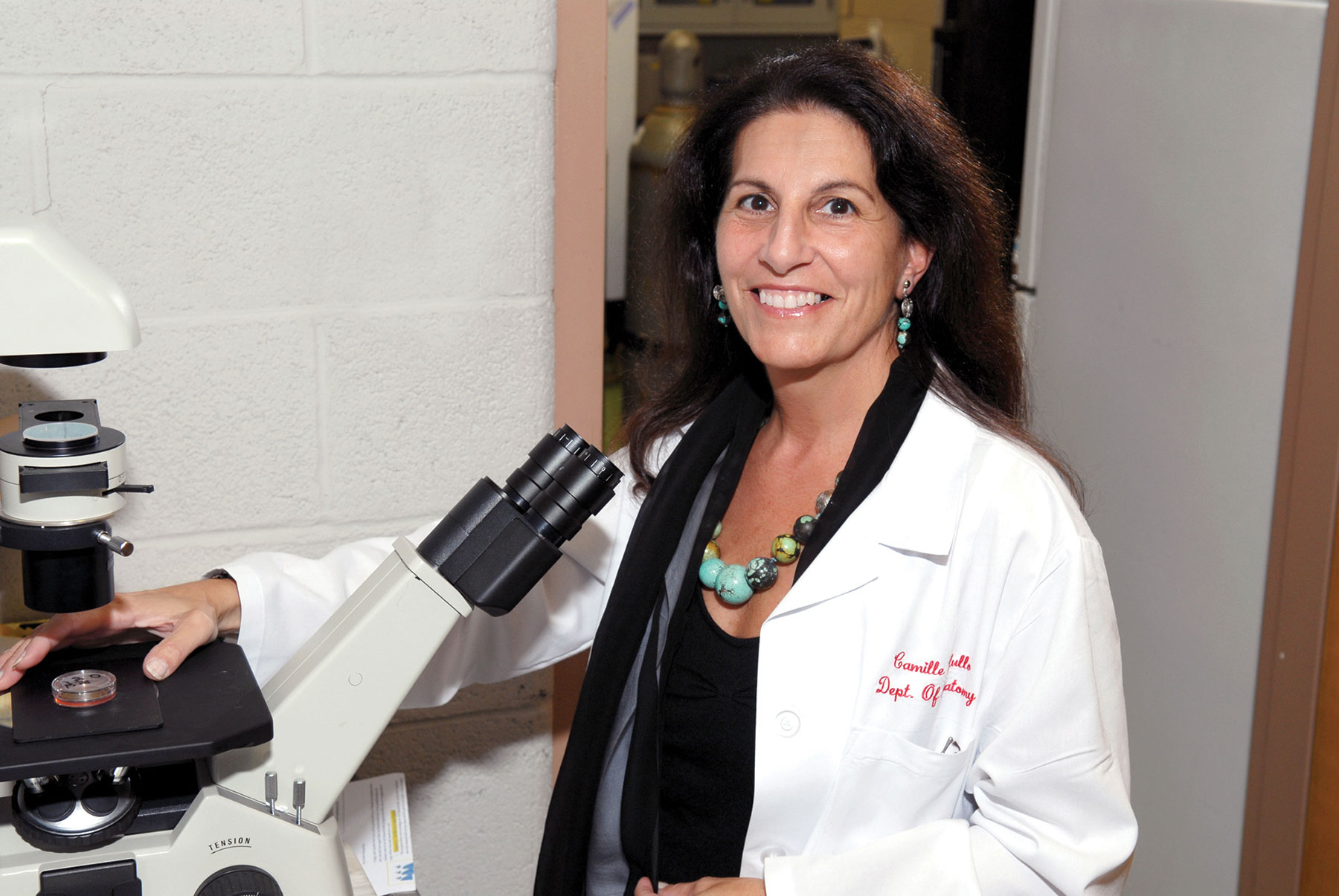Remembering Camille DiLullo, PhD, Professor of Anatomy
January 12, 2016
Dr. DiLullo passed away on May 8, 2015, at age 58, following a battle with cancer.
by Jennifer Schaffer Leone
In a 2013 interview with Digest Magazine, Camille DiLullo, PhD, professor of anatomy, department of bio-medical sciences, shared, “We learn best when we are engaged in endeavors that interest or excite
us. I encourage learners to explore knowledge through the lens of their passions.”
An ardent educator and research scientist whose personal, passionate lens was that
of art, Dr. DiLullo passed away on May 8, 2015, at age 58, following a battle with
cancer. She served Philadelphia College of Osteopathic Medicine for over 21 years,
holding—in addition to her academic position—posts as faculty representative to the
PCOM Boards of Trustees (2011 to 2013) and inaugural member of the PCOM Diversity Council.
Dr. DiLullo’s research focused on the temporal and spatial appearance of cell-specific
proteins during the process of cellular differentiation. Her educational research
centered on the enhancement of learning and the development of expertise for multigenerational
cohorts in medical training.
She was a member of the American Association of Anatomists, the Commission on Osteopathic
College Accreditation, the International Association of Medical Science Educators,
the National Board of Osteopathic Medical Examiners, and the Pennsylvania Muscle Institute.
She served on the editorial board of the International Scholarly Research Notices – Anatomy, and was a reviewer for Anatomical Sciences Education, Clinical Anatomy, MedEdPortal, and Medical Science Educator.
Dr. DiLullo held a bachelor’s degree in biology and art history from La Salle University
and a doctoral degree in anatomy and structural biology from the University of Pennsylvania.
She completed post-doctoral fellowships in cardiovascular training in electron optical
research and in microbiology at the University of Pennsylvania.
An Inspiring Educator and Researcher
During her tenure at PCOM, Dr. DiLullo taught anatomy and neuroscience to over 5,000
osteopathic medical and biomedical sciences students—thereby indirectly impacting
the lives of some 7,000,000 patients. What better tribute is there to a woman who
always had new ideas, novel methods—and who, even in her last days of sickness, incited
the growth of her students, colleagues, and of the College as an institution?
Among Dr. DiLullo’s most reflective initiatives was her approach to first-year human
dissection. While the experience has traditionally taught medical students to emotionally
detach from their patient cadavers, Dr. DiLullo sought to instill empathy. She encouraged
her students to acknowledge the personhood of their cadavers. She insisted that an
interview produced by the Mayo Clinic, between a faculty member and the daughter of
a man who donated his body to medical education, be shown to all first-year students.
This she believed, paired with post-dissection memorial ceremonies, would help students
better process the emotion surrounding the anatomical teaching method.
In one of her last major research projects—through the auspices of a grant from the
Arnold P. Gold Foundation—Dr. DiLullo encouraged novice learners in the Cadaver Dissection
Laboratory Course to employ self-reflection and discussion of the emotional experience
in advancing a humanistic approach to patient-centered health care. She shared her
findings and curricular proposals during a 2014 gathering of the American Association
of Anatomists, a regional meeting that she organized and hosted at PCOM.
Beyond the laboratory, Dr. DiLullo possessed a keen interest in enhancing the comprehensive
learning experiences of her students and the collaboration of her colleagues. She
participated in student orientation activities and designed training modules for students
including interactive workshops, educational learning objects and videos, and core-competency
discussion sessions. For her colleagues, she spearheaded (beginning in 2009) an annual
research retreat that brought together researchers from the Philadelphia and Georgia
campuses and members of PCOM’s MEDNet.
A Friend to Students and Colleagues Alike
“From the beginning, Dr. DiLullo looked at the mess that was me and said, ‘I can help
this one.’ I think that’s what made her so special—her ability to meet her students
where they were and then to work to build them up by liberating them from their fears
and inadequacies,” says Cierra Lewis (MS/Biomed ’16), (DO ’18). For Ms. Lewis, Dr.
DiLullo was “grace and mercy and strength and beauty. She was a demanding teacher,
tutor, confidant, mother-figure, and friend.”
Patrisia Mattioli, senior research assistant, anatomy, who worked closely with Dr.
DiLullo adds: “Camille had a direct style of communication and a quiet sense of humor.
She taught and modeled truth, fairness and objectivity—and urged everyone toward excellence.
In turn, she earned the trust of students and colleagues alike.”
For Tage Kvist, PhD, retired professor of anatomy and chair, department of bio-medical
sciences, Dr. DiLullo was a kind and thoughtful associate. He recalls, “Years ago,
my wife and I underwent a significant house fire and building reconstruction process.
One day, as we were beginning to settle back into our home, Camille came by. She gifted
us with a handsome set of wine glasses to mark our return. That was just the way she
was—thoughtful, generous, gracious.”
An Artist and Aesthetic
For Dr. DiLullo, art and science were branches of the same tree. Dr. DiLullo often
divulged that she did her best science when she was fully engaged with art.
Dr. DiLullo, herself, styled art. “In a sea of blue scrubs, Camille was easy to spot—sporting
an artisan necklace, pin or earrings and her signature stilettos,” says Michael P. McGuinness, PhD, professor of anatomy, department of bio-medical sciences. “When I think of Camille,
I think of classic Hollywood, of women like Katharine Hepburn in The African Queen
who would escape enemy warships without sacrificing impeccable dress and style.”
Moreover, Dr. McGuinness recalls the intellectual enmeshment of art and science Dr.
DiLullo applied to her very approach to observation and investigation: “If you look
at slides from Camille’s lecture presentations, you realize they are unlike anyone
else’s. As faculty, most of us position a title on each slide with an image that we
discuss. Camille’s slides don’t have titles. They have questions. And there isn’t
just a single image; there are multiple images. She didn’t want to tell her students
the meaning of the slides. She wanted them to synthesize and analyze the information.
She wanted her students to approach and appreciate science as they should approach
and appreciate art.”
Marina D’Angelo, PhD, professor of anatomy, department of bio-medical sciences, adds, “Camille brought
an artistic eye and flair to everything she did. She infused creativity into every
task she undertook. Her spirit was vitality, energy, art.”
Dr. DiLullo served as faculty advisor to the PCOM Art Club and sat on the Advisory
Board and Educational Outreach Committee for the La Salle University Art Museum. For
two years, she was engaged in a project to restore her Washington Avenue home to its
late 19th century grandeur, work that was recognized by the Haddonfield (New Jersey)
Preservation Society in 2002.
As many of her colleagues can attest, Dr. DiLullo enjoyed shopping and dancing. Kenneth J. Veit, DO ’76, MBA, provost, senior vice president for academic affairs and dean, remembers travel with
Dr. DiLullo to academic conferences: “Camille loved to shop and would walk all over
the city, wherever we were. She attacked this field of study—fearlessly and relentlessly—as
both scientist and artist. She discovered special, out of the way stores, not necessarily
recommended in tourist guides, and bought unique gifts for herself and many friends.”
He continues: “And she loved dancing; she truly fancied the sequences of human movement.
Camille always seemed to make each moment worth living, to understand what it meant
to be alive.”
A Proponent of Women in Science
Dr. DiLullo was unyielding in her commitment to the education, training and mentoring
of women and to overall gender equity in higher education. She nurtured promising
young scientists and future physicians—many minorities—through the Physician Scientist
Training program. And she disclosed her personal struggles and experiences through
the FabFems Project and STEM Role Models, national advising initiatives designed to
inspire and engage women in the science, technology, engineering and mathematics pipeline
and to increase their retention in these fields.
“Growing up I always wanted to be a doctor—ALWAYS,” her endearing mentor profile begins.
In it, Dr. DiLullo recounts the obstacles she confronted as a first-generation college
student, receiving limited support from teachers and counselors; the complications
she faced focusing and refocusing her career path, ever torn by an equal love of science
and art; the anguish she felt as she was rejected from academic programs and posts;
and the self-discipline she discovered that comes from persistence of action and vision.
Furthermore, she tackles prejudice with candor, describing unconscious acts of gender
bias in a scientific work environment.
But above all, she proffers genuine pointers to encourage and edify: “Don’t be dissuaded
from what you believe is the right path”; “Recognize opportunities and take full advantage
of those that are available to you”; and “Consciously engage in all the aspects of
your life that bring you happiness.”


